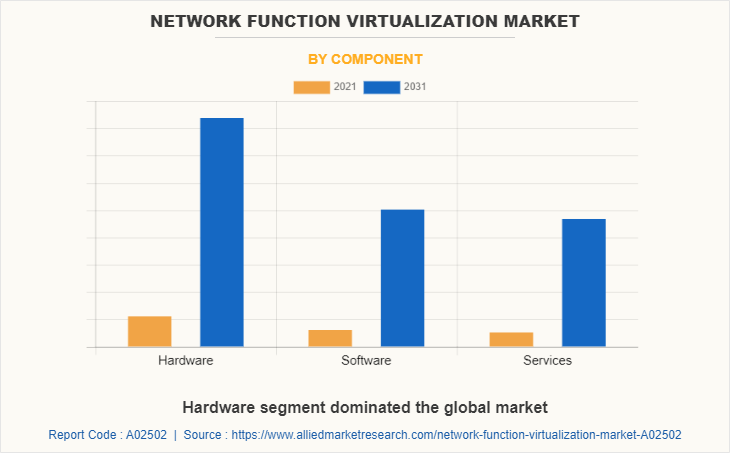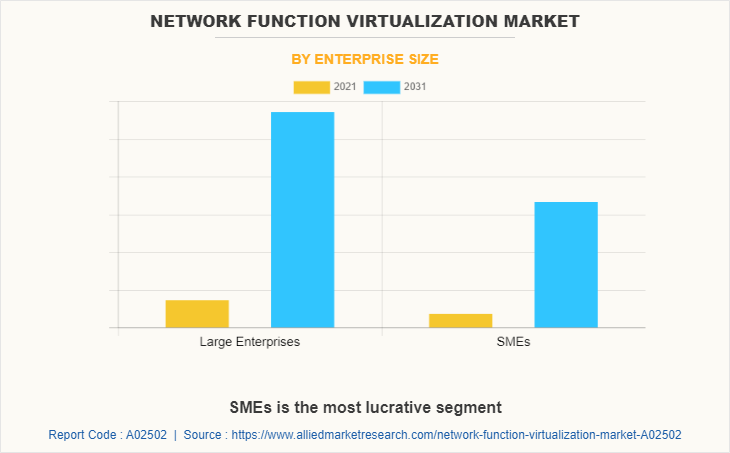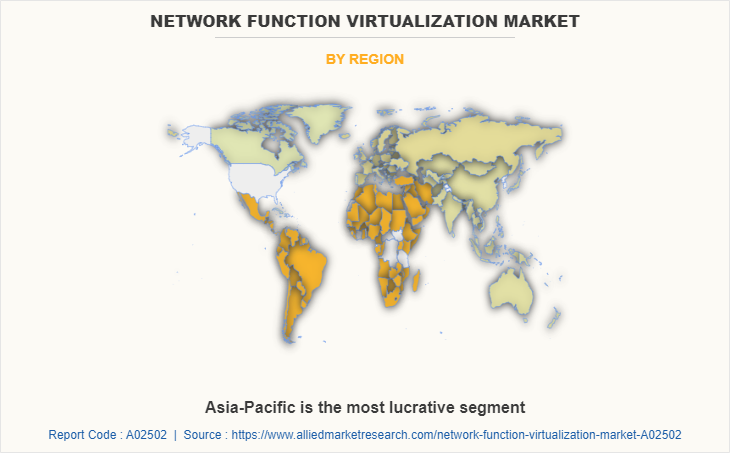Network Function Virtualization Market Insights:
The global network function virtualization market was valued at USD 21.90 billion in 2021 and is projected to reach USD 180.67 billion by 2031, growing at a CAGR of 23.8% from 2022 to 2031.
Network function virtualization (NFV) is a combination of hardware and software network that deals in virtual network. It assists in optimizing the networks and related operations, and reduces power consumption, thus decreasing equipment cost. It facilitates accessibility of several applications on one single network appliance. Decrease in capital and operational expenditure is a major advantage offered by network function virtualization. Furthermore, increase in deployment of virtualized software among enterprise data centers, including internet service providers (ISP) and cloud service providers (CSP), drives the market growth. Moreover, increase in demand for data-intensive applications and the need for cloud-based services are expected to provide lucrative growth opportunities for network function virtualization market size.

The network function virtualization market is segmented into Component, Enterprise Size and End User.By component, it is divided into hardware, solution and services. On the basis of enterprise size, it is categorized into large enterprises and SMEs. By end user, it is segregated into service providers, data centers and enterprises. Region wise, it is analyzed across North America, Europe, Asia-Pacific, and LAMEA.
On the basis of component, the hardware segment dominated the network function virtualization (NFV) market in 2021, and is expected to continue this trend during the forecast period. The virtualization of network functions reduces dependency on dedicated hardware appliances for network operators, and allows for improved scalability and customization across the entire network. Such benefits provide numerous opportunities for the growth of the hardware segment. However, services segment expected to witnesses the highest growth in the network function virtualization market forecast period. Services play a vital role in the NFV market, as services focus on meeting client requirements, including reduced cost and enhanced software performance. There has been an increase in the adoption of services among end users over time, as it ensures effective functioning of software and platforms throughout the process.

On the basis of enterprise size, the large enterprises segment captured the largest market share in 2021, and is expected to continue this trend during the forecast period. Network function virtualization facilitates large enterprises for the expansion of network resources as well as new servers while minimizing the administrative burden. The combination of orchestration, automation, and programmability provided by virtualization enables the IT department of large enterprises to become more agile. However, SMEs segment is expected to witness the highest growth market share in the upcoming year. Surge in need to make business more streamlined, and rise in need to improve efficiency by shortening the time taken to troubleshoot a solution majorly drive the network function virtualization market growth among small- & medium-sized businesses.

Depending on the region, North America dominated the network function virtualization market share in 2021. In this region, businesses are investing in their emerging technologies in order to implement streamline work processes. The NFV market in North America is aided by the early and fast adoption of technologies, such as cloud computing, software defined everything (SDx), and IoT. This favorable standards and networking regulations helps in boosting the market growth in this region. However, Asia-Pacific is expected to exhibit highest growth during the forecast period. The region has a robust IT infrastructure and solid software and service offerings. In addition, rise in penetration of cloud-based services drive growth of the market in this region.

Top Impacting Factors:
Factors such as rise in adoption of NFV to reduce complexity, ease management and rapid advancement and accelerating digitalization in businesses fuels the growth of the market. In addition, increase in deployment of virtualized software among enterprises including data center and service provider drive the growth of the network function virtualization market. Furthermore, increase in adoption of emerging technologies such as 5G and Edge computing and rise in demand for cloud-based services is expected to provide lucrative growth opportunities for the market in the upcoming year. However, security issue and lack of standards hamper the market growth.
Increasing deployment of virtualized software among enterprises:
The ever-increasing demand for digital infrastructure that incorporates private and cloud systems propels adoption of virtual applications technology. Virtualized software has been optimized to run on virtual infrastructure, which is more ideal scenario, which offers IT infrastructure more mobile, agile, and secure. Further, virtual desktop infrastructure allows to centrally manage the computers much faster than using traditional imaging technologies. Hence, offering lucrative opportunities for network function virtualization market growth. However, high rise associated with AI-powered virtualized software is propelling the growth of network function virtualization industry.
Furthermore, the emergence of ideas, such as multi-cloud platforms-based virtualized software, has been gaining popularity, which has been anticipated to enhancing adoption of virtualized software among enterprise including service provider and data center.
Key Benefits for Stakeholders:
- This report provides a quantitative analysis of the market segments, current trends, estimations, and dynamics of the network function virtualization market analysis from 2021 to 2031 to identify the prevailing network function virtualization market opportunities.
- The network function virtualization market research is offered along with information related to key drivers, restraints, and opportunities.
- Porter's five forces analysis highlights the potency of buyers and suppliers to enable stakeholders make profit-oriented business decisions and strengthen their supplier-buyer network.
- In-depth analysis of the network function virtualization market segmentation assists to determine the prevailing network function virtualization market opportunities.
- Major countries in each region are mapped according to their revenue contribution to the global market.
- Market player positioning facilitates benchmarking and provides a clear understanding of the present position of the market players.
- The report includes the analysis of the regional as well as global network function virtualization market trends, key players, market segments, application areas, and market growth strategies.
Network function virtualization Market Report Highlights
| Aspects | Details |
| By Component |
|
| By Enterprise Size |
|
| By End User |
|
| By Region |
|
| Key Market Players | Mavenir, Ciena Corporation, DELL EMC, Juniper Networks, Inc., ECI Telecom, Ericsson, Cisco Systems, Inc., NetScout Systems, Inc., Nokia Corporation, Wind River Systems, Inc., VMware, Inc., FUJITSU LIMITED, Affirmed Networks, ZTE Corporation, Huawei Technologies Co., Ltd., Comba Telecom Systems, Hewlett Packard Enterprise Company |
Analyst Review
Enterprises have witnessed various changes in business processes, operations, and industrial automation. Moreover, organizations are shifting toward digitalization and increase in implementation of Industry 4.0 to cope with ongoing tough business competition. This eventually creates the need for network function virtualization (NFV) in sectors for enhance the work process. Furthermore, Virtualized network function has gained high traction in recent years, owing to the rise in the adoption of cloud computing solutions globally. Further, the rise in virtual infrastructure across prime enterprises is driving the need for complex security applications for virtualized software; therefore, forecast to offers lucrative growth opportunities for the market growth. Furthermore, it allows users to maintain a secure network infrastructure within an enterprise. In addition, the rise in demand for self-service applications is expected to offer profitable opportunities for the market.
The global network function virtualization market is highly competitive, owing to the strong presence of existing vendors. The NFV vendors, who have access to extensive technical and financial resources, are anticipated to gain a competitive edge over their rivals, as they have the capacity to cater to the market requirements. The competitive environment in this market is expected to further intensify with increase in technological innovations, product extensions, and different strategies adopted by key vendors.
On the contrary, rise in growth of demand for hybrid cloud infrastructure globally are driving the need for next generation to enhance virtualization technology. Moreover, prime economics, such as Germany and Japan, plan to developing and deploying next-generation virtualization security across various sectors. For instance, the South Korean government has planned to invest $607 million into countries' cybersecurity capabilities, which is anticipated to provide lucrative opportunities for market growth.
Furthermore, these enhancements to Symantec Endpoint Security Complete (SESC) bring a new level of comprehensive security by eliminating common blind spots in most enterprise security infrastructures. In addition, enterprises are also constantly adding new features to SESC, such as “Granular Activity Recorder Rules,” to help analysts and system administrators collect data even more efficiently and eliminate unnecessary event noises. Such developments and advancements drive the growth of the market.
The network function virtualization (NFV) market was valued at $ 26.44 billion in 2022, and is projected to reach $180.67 billion by 2031, registering a CAGR of 23.8%.
Increase in adoption of emerging technologies such as 5G and Edge computing and rise in demand for cloud-based services is expected to provide lucrative growth opportunities for the market in the upcoming year. However, security issue and lack of standards hamper the market growth
The enterprises segment dominated the growth in 2021
Depending on the region, North America dominated the market in 2021.
The market players operating in the network function virtualization (NFV) market, which includes Affirmed Networks, Ciena, Cisco Systems, Inc., Comba telecom systems, Dell EMC, ECI Telecom, Ericsson, Fujitsu Limited, Hewlett Packard Enterprise, Huawei Technologies Co., Ltd., NEC Corporation, Mavenir, NETSCOUT, Nokia Corporation, VMware, Inc., Wind River Systems, Inc. and ZTE Corporation.
Loading Table Of Content...



